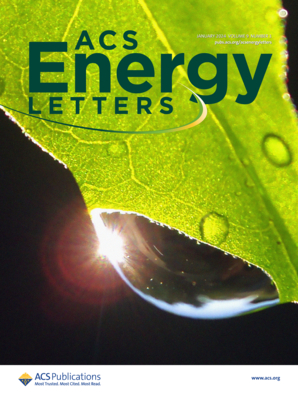Atomistic Insights into Solid-State Phase Transition Mechanisms of P2-Type Layered Mn Oxides for High-Energy Na-Ion Battery Cathodes
IF 18.2
1区 材料科学
Q1 CHEMISTRY, PHYSICAL
引用次数: 0
Abstract
Mn-based layered oxides hold great promise as high-energy, cost-effective cathodes for sodium-ion batteries (NIBs), but repetitive Na+ cycling induces harmful phase transitions. Understanding these mechanisms is essential for designing better performing NIB cathodes. Applying density functional theory (DFT) and variable cell-nudged elastic band (VC-NEB) calculations, we provide atomistic insights into phase transformation pathways and energy barriers in P2-NaxMnO2 material and its Ni-doped variant. We reveal the key P2-to-OP4/O2 and P2-to-P2′ transitions that occur across various sodiation levels, involving substantial rearrangements around the transition metal sites, with tetrahedral transition states accountable for energy barriers. Our analysis of bond length and angle distortions highlights that shear deformations are pivotal in triggering P-to-O gliding at low sodium levels. Based on these insights, our structural distortion metrics offer a straightforward and computationally efficient descriptor to evaluate structural integrity for these layered oxides, enabling the design of NIBs with improved stability and extended lifespan.

高能钠离子电池阴极中p2型层状锰氧化物固态相变机理的原子学研究
锰基层状氧化物作为钠离子电池(nib)的高能量、低成本阴极具有很大的前景,但重复的Na+循环会导致有害的相变。了解这些机制对于设计性能更好的NIB阴极至关重要。应用密度泛函理论(DFT)和可变细胞微推弹性带(VC-NEB)计算,我们提供了P2-NaxMnO2材料及其ni掺杂变体的相变途径和能量势垒的原子见解。我们揭示了p2到op4 /O2和p2到p2 '的关键转变发生在不同的钠化水平上,涉及过渡金属位点周围的大量重排,四面体过渡态负责能量势垒。我们对键长和角度扭曲的分析强调,剪切变形是在低钠水平下触发P-to-O滑动的关键。基于这些见解,我们的结构扭曲指标为评估这些层状氧化物的结构完整性提供了一个简单且计算效率高的描述,从而使nib的设计具有更高的稳定性和更长的使用寿命。
本文章由计算机程序翻译,如有差异,请以英文原文为准。
求助全文
约1分钟内获得全文
求助全文
来源期刊

ACS Energy Letters
Energy-Renewable Energy, Sustainability and the Environment
CiteScore
31.20
自引率
5.00%
发文量
469
审稿时长
1 months
期刊介绍:
ACS Energy Letters is a monthly journal that publishes papers reporting new scientific advances in energy research. The journal focuses on topics that are of interest to scientists working in the fundamental and applied sciences. Rapid publication is a central criterion for acceptance, and the journal is known for its quick publication times, with an average of 4-6 weeks from submission to web publication in As Soon As Publishable format.
ACS Energy Letters is ranked as the number one journal in the Web of Science Electrochemistry category. It also ranks within the top 10 journals for Physical Chemistry, Energy & Fuels, and Nanoscience & Nanotechnology.
The journal offers several types of articles, including Letters, Energy Express, Perspectives, Reviews, Editorials, Viewpoints and Energy Focus. Additionally, authors have the option to submit videos that summarize or support the information presented in a Perspective or Review article, which can be highlighted on the journal's website. ACS Energy Letters is abstracted and indexed in Chemical Abstracts Service/SciFinder, EBSCO-summon, PubMed, Web of Science, Scopus and Portico.
 求助内容:
求助内容: 应助结果提醒方式:
应助结果提醒方式:


